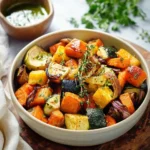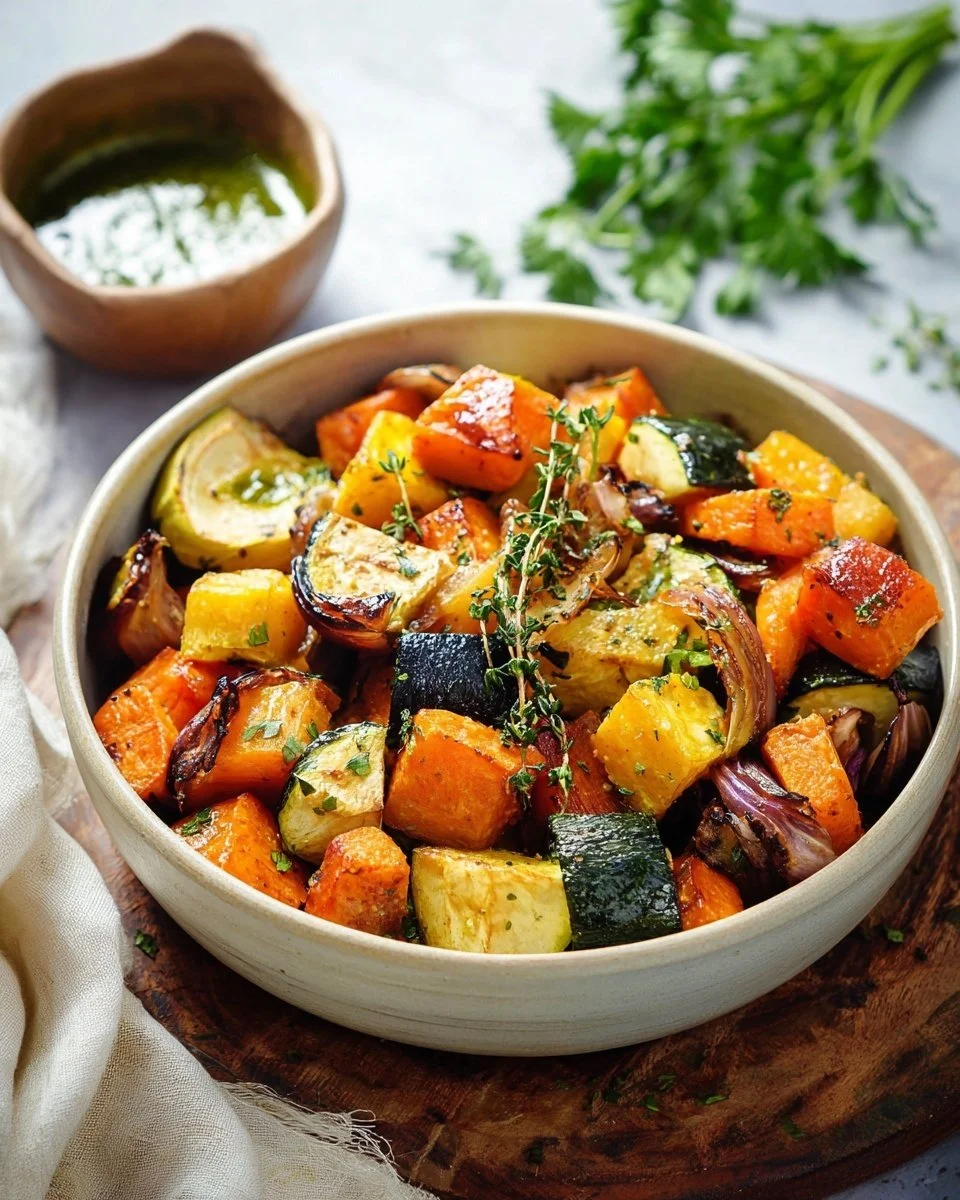Why Make This Recipe
Roasted root vegetables with balsamic glaze is a delightful dish that brings together a colorful medley of flavors and textures. This recipe highlights the natural sweetness of various vegetables, enhanced by a rich balsamic glaze. It’s perfect for a cozy family dinner, a holiday gathering, or even as a side dish at a potluck.
Moreover, roasting amplifies the vegetables’ flavors, creating a delightful caramelization that makes each bite a little burst of deliciousness. It is also a nutritious option that caters to a wide range of dietary preferences, making it a great addition to your cooking repertoire.
Equipment Needed for Roasted Root Vegetables with Balsamic Glaze
To successfully prepare roasted root vegetables with balsamic glaze, you will need a few essential pieces of equipment. First, an extra-large, rimmed baking sheet is a must. If cooking for a larger crowd, two large baking sheets will work just fine.
You will also need a large mixing bowl for tossing the vegetables with the dressing. Measuring cups and spoons come in handy for precise ingredient measurements. Lastly, a sharp knife and cutting board are essential to cut the vegetables easily and safely.
What You Need to Make Roasted Root Vegetables with Balsamic Glaze
To create this delicious dish, gather the following ingredients:
1 pound sweet potatoes, (cut into 1 ¼-inch cubes)
¾ pound carrots, (cut into 1 ¼-inch pieces)
¾ pound parsnips, (cut into 1 ¼-inch pieces)
1 acorn squash, (seeded, cut into 1 ¼-inch pieces)
1 large red onion, (peeled, with root end left intact cut into ½-inch wedges)
¼ cup extra-virgin olive oil
3 tablespoons balsamic vinegar
2 tablespoons maple syrup
1 tablespoon fresh thyme leaves (or rosemary)
Salt and pepper to taste
Nonstick cooking spray
Carrot Top Cashew Pesto (optional)
How to Cook Roasted Root Vegetables with Balsamic Glaze Step by Step
Start by preheating your oven to 425°F. This high temperature is key to getting the perfect roast on your vegetables, allowing them to caramelize nicely. While the oven is heating, prepare a baking sheet. If you are using an extra-large rimmed baking sheet (20×15), spray it with non-stick cooking spray. Alternatively, if using two smaller sheets (18×12), make sure to coat them both to prevent sticking.
Next, take a large bowl and gather your sweet potatoes, carrots, parsnips, acorn squash, and red onion. Place them in the bowl, ensuring they are evenly mixed. Now, drizzle in the olive oil, balsamic vinegar, and maple syrup. Sprinkle the fresh thyme leaves (or rosemary), along with a generous amount of salt and black pepper over the vegetables. This mixture is what brings all the flavors together, so make sure to toss everything well until all the vegetables are coated evenly.
Once mixed, spread the vegetables out evenly on the prepared baking sheet(s). It’s vital to arrange them in a single layer for the best roasting effect. If the vegetables are overcrowded, they will steam instead of roast, so keep that in mind. Place the baking sheet in the preheated oven and roast the vegetables uncovered for approximately 40 to 45 minutes. Halfway through the cooking time, stir the vegetables gently. This helps ensure they cook evenly and brown nicely.
If you plan to prepare the dish ahead of time, you can make the roasted root vegetables up to three hours in advance. After roasting, transfer them to a clean baking sheet and allow them to stand at room temperature. When you are ready to serve, rewarm them in the oven at 375°F for about 10 to 15 minutes. For an extra flavor burst, serve the dish with the optional Carrot Top Cashew Pesto.
How to Serve Roasted Root Vegetables with Balsamic Glaze
Serving roasted root vegetables with balsamic glaze is quite simple. They can be the star of the dish or a lovely complementary side. When dishing up, present the vegetables in a vibrant bowl to highlight their colorful appearance.
If using the Carrot Top Cashew Pesto, drizzle it over the top or offer it on the side for guests to add as they wish. The richness of the pesto enhances the vegetables’ flavors, bringing a lovely creamy texture to the dish.
As a centerpiece, this recipe makes an excellent main dish for vegetarians, or serve it alongside roasted chicken or pork for a hearty meal. The combination of flavors pairs beautifully with various proteins, making this a versatile dish suitable for different occasions.
What to Serve with Roasted Root Vegetables with Balsamic Glaze
Roasted root vegetables with balsamic glaze offers numerous pairing possibilities. To create a balanced meal, consider serving them alongside proteins like grilled chicken, beef tenderloin, or baked salmon. Each of these options complements the sweet and tangy flavors of the vegetables, creating a well-rounded dinner.
You can also serve them with grains like quinoa or couscous. The nutty flavors of these grains bring additional texture and heartiness to the meal. A fresh green salad or a light coleslaw can serve as a refreshing side, balancing the rich roasted vegetables.
For a more festive occasion, consider serving these roasted vegetables with creamy mashed potatoes or a savory stuffing. These traditional sides make for a cozy and satisfying meal.
How to Store Roasted Root Vegetables with Balsamic Glaze
If you have leftover roasted root vegetables with balsamic glaze, store them properly to keep them fresh. Allow the vegetables to cool completely before transferring them to an airtight container. Keeping them sealed helps preserve their flavor and texture.
You can store them in the refrigerator for up to three days. When you are ready to enjoy the leftovers, you can either eat them cold or reheat them in the oven or microwave. If reheating in the oven, place them on a baking sheet at 375°F for about 10 to 15 minutes until warmed through.
It’s best to avoid freezing the roasted vegetables, as the texture may suffer. Freezing can cause them to become mushy when thawed, which detracts from their intended delightful texture.
Tips to Make Roasted Root Vegetables with Balsamic Glaze
To achieve the best results with your roasted root vegetables, keep a few tips in mind. First, ensure that all the vegetables are cut to a similar size. This helps ensure even cooking since larger pieces will take longer to roast compared to smaller ones.
Don’t skip the step of stirring the vegetables halfway through roasting. This is essential for achieving an even brownness and prevents burning on one side.
Feel free to customize the recipe by using seasonal vegetables. If you can’t find parsnips or acorn squash, try substituting them with turnips or butternut squash.
Using fresh herbs enhances the flavor significantly, so opt for freshly picked thyme or rosemary if possible. Dried herbs can work in a pinch, but fresh always provide a brighter taste. Finally, adjusting the amount of balsamic vinegar and maple syrup allows you to tailor the sweetness and tanginess to your preference.
Variation
The beauty of roasted root vegetables lies in their versatility, allowing for numerous variations. If you are looking to switch things up, try incorporating other vegetables into the mix. Brussels sprouts, butternut squash, and beets can add flavor and color diversity.
For a spicy kick, toss in some red pepper flakes or a pinch of cayenne pepper along with the salt and pepper. You could also opt for different glazes, like a honey mustard or citrus-infused glaze, altering the flavor profile of the dish entirely.
For a twist on the original recipe, consider changing the herb. Instead of thyme, you can use oregano, sage, or even dill for a unique flavor.
Best Time to Make Roasted Root Vegetables with Balsamic Glaze
Roasted root vegetables with balsamic glaze is an excellent recipe any time of the year. However, it shines particularly during the autumn and winter months when root vegetables are in season.
Fall harvests bring a bounty of sweet potatoes, carrots, and parsnips, making this a perfect occasion to whip up a batch. During the holidays, offering this dish as part of your meal can showcase seasonal produce and create a festive atmosphere. The warm, comforting flavors are ideal for holiday meals, potlucks, and family gatherings.
Common Mistakes to Avoid
While making roasted root vegetables might seem straightforward, there are a few common pitfalls to avoid for the best results. One mistake often made is overcrowding the baking sheet. When packed too closely together, vegetables steam rather than roast, leading to a lackluster texture. Stick to a single layer for optimal results.
Another error is not allowing enough time for roasting. Under-roasted vegetables can be hard and unappealing. Be sure to check for tenderness and caramelization at the 40-minute mark. Cooking longer as needed will enhance both taste and texture.
Finally, avoid under-seasoning. Salt and pepper enhance flavors, so don’t be shy in adding enough seasoning. Tasting the mixture before roasting can help ensure that everything is balanced for your palate.
Nutritional Notes
Roasted root vegetables are not only delicious but also offer many nutritional benefits. Root vegetables are rich in vitamins, minerals, and fiber. Sweet potatoes, for example, are an excellent source of vitamin A, promoting healthy skin and vision. Carrots are known for their beta-carotene, contributing to eye health and immune function.
Incorporating a variety of root vegetables ensures that you receive a range of nutrients. Parsnips and acorn squash provide essential minerals such as potassium and magnesium, which are vital for heart health and energy production.
FAQs
Can I use different vegetables for this recipe?
Absolutely! Feel free to substitute with other root vegetables like beets, turnips, or even sweet corn to keep things fresh and interesting.
How long do leftovers last?
Leftovers can be stored in an airtight container in the refrigerator for up to three days.
Can I prepare this dish in advance?
Yes, you can roast the vegetables ahead of time. Just reheat them in the oven before serving for the best results.
Conclusion
Roasted root vegetables with balsamic glaze is a versatile and satisfying dish that can elevate any meal. Its combination of flavors, textures, and colors makes it a favorite for many. With easy preparation and a quick roasting method, you can enjoy this delightful dish at any time.
Remember to customize the recipe to suit your taste and preferences. This way, you can create a unique dish that will be sure to impress family and friends alike. Happy cooking!

Roasted Root Vegetables with Balsamic Glaze
Ingredients
Method
- Preheat your oven to 425°F (220°C).
- Prepare a baking sheet by spraying it with nonstick cooking spray.
- In a large mixing bowl, combine the sweet potatoes, carrots, parsnips, acorn squash, and red onion.
- Drizzle the olive oil, balsamic vinegar, and maple syrup over the vegetables.
- Add fresh thyme (or rosemary), salt, and pepper. Toss well until the vegetables are evenly coated.
- Spread the vegetables in a single layer on the prepared baking sheet.
- Roast the vegetables uncovered in the preheated oven for 40 to 45 minutes, stirring halfway through.

